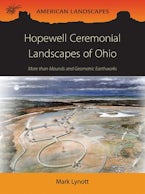Nearly 2000 years ago, people living in the river valleys of southern Ohio built earthen monuments on a scale that is unmatched in the archaeological record for small-scale societies. The period from c. 200 BC to c. AD 500 (Early to Middle Woodland) witnessed the construction of mounds, earthen walls, ditches, borrow pits and other earthen and stone features covering dozen of hectares at many sites and hundreds of hectares at some. The development of the vast Hopewell Culture geometric earthwork complexes such as those at Mound City, Chilicothe; Hopewell; and the Newark earthworks was accompanied by the establishment of wide-ranging cultural contacts reflected in the movement of exotic and strikingly beautiful artefacts such as elaborate tobacco pipes, obsidian and chert arrowheads, copper axes and regalia, animal figurines and delicately carved sheets of mica. These phenomena, coupled with complex burial rituals, indicate the emergence of a political economy based on a powerful ideology of individual power and prestige, and the creation of a vast cultural landscape within which the monument complexes were central to a ritual cycle encompassing a substantial geographical area.
The labour needed to build these vast cultural landscapes exceeds population estimates for the region, and suggests that people from near (and possibly far) travelled to the Scioto and other river valleys to help with construction of these monumental earthen complexes. Here, in the first American Landscapes volume, Mark Lynott draws on more than a decade of research and extensive new datasets to re-examine the spectacular and massive scale Ohio Hopewell landscapes and to explore the society that created them.
I. More than Mounds and Ditches, an Introduction to Ohio Hopewell Ceremonial Landscapes
Ohio and the Beginning of North American Archaeology
Mortuary Mounds and Artifacts
Expanding Research Interests in earthworks and ceremonial centers
Ohio Hopewell Constructed Landscapes and the Digital Revolution
Ohio Hopewell – an iconic name and iconic sites, but what is it?
II. Current Issues in the Construction of Ohio Hopewell ceremonial landscapes
Hopewell Variation and Distribution
Time and Hopewell Archaeology
Energy analysis: How many people did it take to build Ohio Hopewell Ceremonial Landscapes
Sedentary Farmers or Mobile Foragers?
Mensuration, Geometry, Alignments and Reading the Heavens
Alignments and Reading the Heavens
The Great Hopewell Road
Were ceremonial landscapes planned designs? Models and hypotheses.
III. The Hopeton Earthworks Project
Geophysical Survey and Trench Excavations
Embankment Wall Features
Geoarchaeology
Radiocarbon Results
Non-embankment wall features
Near The Earthworks: Triangle, Red Wing, Overly, and Cryder sites
What have we learned about the Hopeton Earthworks?
IV. Studies of Ohio Hopewell Ceremonial Landscapes
Southeastern Ohio
Newark Earthworks
Marietta
Scioto River Valley
Seip
High Bank Earthwork
Anderson Earthwork
Mound City
Hopewell Mound Group
Shriver Circle
Southwest Ohio – Brush Creek, The Great Miami and Little Miami River drainages
Fort Hill, Highland County
Fort Ancient
Foster’s Crossing
Pollock Works
Miami Fort
Turner Group of Earthworks
Stubbs Earthwork
V: What do we know about Hopewell ceremonial landscapes?
Constructed Landscapes, Site Preparation and Planning
Material Selection and the Placement of material: art or engineering?
Landscape Features - Unique and Diverse
Time and Landscape Construction
How Were Ceremonial Landscapes Used?
Ritual Refuse Pits at the Riverside Site, Hopewell Mound Group
The Moorehead Circle
Craft Houses and Other Wooden Structures
A Great Post Circle and Many Buildings
Beyond the Enclosure at Mound City
Some additional thoughts
VI. Some Final Thoughts: What We Still Need to Learn
Landscapes and Time
The Meaning Behind Landscape Forms
Beyond Southern Ohio
Future studies and final thoughts
VII. References

